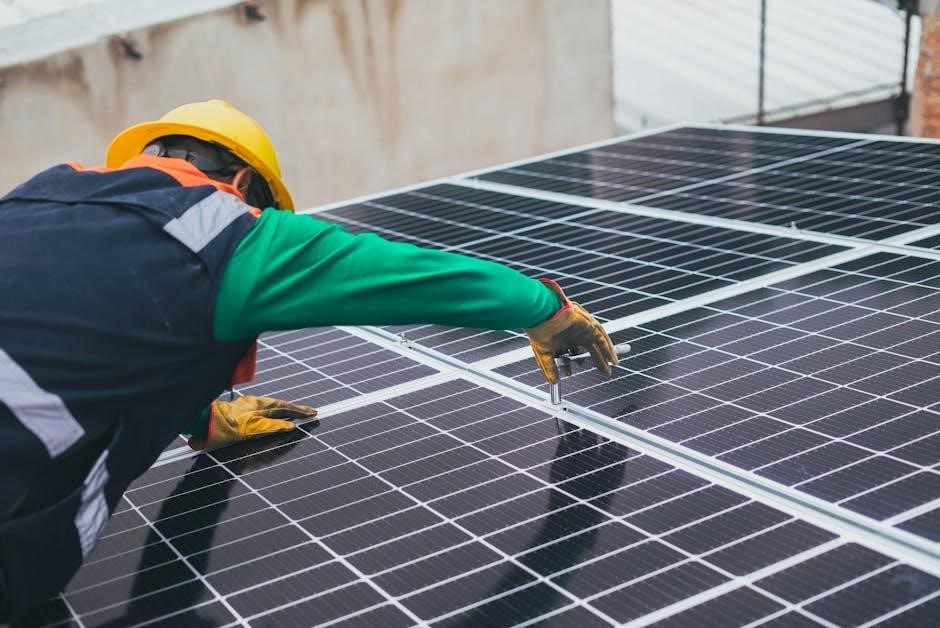Welcome to our comprehensive guide on ductwork installation! This section introduces the fundamentals of ductwork systems, their importance in HVAC efficiency, and the essential considerations for proper installation to ensure optimal airflow and performance. Learn how to plan, execute, and maintain ductwork systems effectively.
1.1 Overview of Ductwork Systems
Ductwork systems are networks of channels that distribute air throughout buildings, ensuring efficient heating, cooling, and ventilation. They consist of rigid or flexible ducts, fittings, and vents, designed to maintain consistent airflow and pressure. Properly installed ductwork enhances HVAC performance, reduces energy consumption, and improves indoor air quality. The layout and assembly of these systems are critical, as they directly impact system efficiency and long-term functionality. Understanding the components and their roles is essential for installers to ensure optimal performance and meet safety standards. This section provides a foundational understanding of ductwork systems, setting the stage for detailed installation guidance.
1.2 Importance of Proper Installation
Proper ductwork installation is crucial for ensuring efficient HVAC system performance, energy savings, and indoor air quality. Incorrectly installed ducts can lead to leakage, poor airflow, and increased energy bills. A well-executed installation minimizes risks of moisture damage, mold growth, and safety hazards. Additionally, it ensures compliance with local building codes and manufacturer warranties. Proper installation also extends the lifespan of the HVAC system by reducing strain on components. By following guidelines and best practices, installers can achieve a reliable, durable, and high-performing ductwork system that meets the needs of the building and its occupants. This section emphasizes the significance of meticulous installation techniques for optimal results.
1.3 Safety Precautions and Guidelines
Ensuring safety during ductwork installation is paramount to prevent injuries and system damage. Always wear personal protective equipment (PPE), such as gloves and safety glasses, when handling sharp materials. Properly support ducts during installation to avoid accidents and structural damage. Follow manufacturer guidelines for handling and storing materials to prevent wear and tear. Ensure all power tools are used correctly, and keep loose clothing tied back. Never bypass safety protocols, as improper installation can lead to system malfunctions or safety hazards. Additionally, ensure the system is installed by a qualified professional to maintain warranty validity and compliance with local codes. Adhering to these guidelines ensures a safe and efficient installation process.

Materials and Components
Ductwork systems rely on high-quality materials, including rigid and flexible ducts, insulation, and specialized fittings. Accessories like vents and registers ensure efficient airflow and system performance.
2.1 Types of Ducts: Rigid vs. Flexible
Rigid ducts, typically made of metal or fiberglass, are durable and ideal for straight runs, offering superior airflow and minimal leakage. Flexible ducts, constructed with insulated, flexible materials, are perfect for navigating tight spaces and reducing noise. Proper selection between rigid and flexible ducts depends on the specific HVAC system requirements, space constraints, and desired performance efficiency. Each type has unique installation considerations, with rigid ducts requiring precise fitting and flexible ducts needing careful handling to avoid kinking and damage. Balancing these factors ensures an optimal ductwork system for any application.
2.2 Insulation and Soundproofing Materials
Proper insulation and soundproofing are critical for maximizing energy efficiency and reducing noise in ductwork systems. Common materials include fiberglass, foam insulation, and acoustic liners, which help minimize heat loss and prevent sound transmission. Insulation thickness and type should be selected based on the system’s operating conditions and environmental requirements. For instance, wrapped insulation is ideal for exterior ducts, while internal coatings are used for sound dampening. Ensuring airtight seals and proper installation of these materials is essential to maintain system performance and prevent energy loss. Additionally, soundproofing materials like mass-loaded vinyl can be applied to ducts to further reduce operational noise.
2.3 Accessories: Fittings, Vents, and Registers
Accessories such as fittings, vents, and registers are essential for a functional ductwork system. Fittings, including elbows, tees, and couplers, enable proper airflow direction and connection between duct segments. Vents and registers regulate air distribution, ensuring even circulation throughout the space; These components are typically made from materials like galvanized steel, aluminum, or plastic, chosen for durability and compatibility with the duct system. Proper installation of these accessories is critical to maintain system efficiency and prevent leaks. They also allow for customization, such as adjusting airflow in specific areas. Regular inspection and maintenance of these parts ensure optimal performance and longevity of the ductwork system.

Tools and Equipment
Essential tools for ductwork installation include hand tools like snips, screwdrivers, and wrenches, as well as power tools such as drills and saws. Measuring devices like tape measures and duct calculators ensure accuracy. Safety equipment, including gloves and goggles, is crucial for protection. Specialized machinery, like ductforming equipment, may also be required for precise installations.
3.1 Essential Hand Tools for Ductwork
For ductwork installation, essential hand tools include metal snips for cutting ducts, screwdrivers for securing fittings, and wrenches for tightening connections. Pliers and hammers are useful for shaping and fitting duct sections. Utility knives and saws assist in trimming insulation and cutting materials. Tape measures and levels ensure accurate installations. Safety tools like gloves and goggles protect against sharp edges and debris. Maintaining these tools in good condition and organizing them efficiently can significantly speed up the installation process. Always refer to the installation guide for specific tool recommendations tailored to your ductwork project.
3.2 Power Tools and Machinery
Power tools and machinery are indispensable for efficient ductwork installation. Drills and impact wrenches are used for securing screws and bolts, while reciprocating saws and circular saws excel at cutting duct materials. Sheet metal shears and nibblers are essential for precise cuts without damaging the metal. Additionally, a duct crimper is crucial for forming tight connections between duct sections. For larger projects, consider using automatic duct-forming machines to streamline production. Vacuum pumps and pressure testers ensure system integrity by detecting leaks. Always follow safety guidelines and maintenance recommendations for these tools to optimize performance and longevity. Proper use of power tools ensures professional-grade results in ductwork projects.
3.3 Measuring and Testing Equipment
Accurate measurement and testing are critical for ensuring ductwork installation quality. Essential tools include pressure gauges to measure static pressure and airflow meters to verify air velocity. Temperature and humidity sensors help assess environmental conditions. Leak detection kits, such as smoke generators or pressure testing tools, identify gaps or seal failures. Digital multimeters are used to test electrical connections in HVAC systems. Manometers measure pressure drops across duct sections, while duct calipers ensure proper sizing. Regularly calibrate these tools to maintain accuracy. Proper testing ensures system efficiency, safety, and compliance with design specifications, preventing costly rework and ensuring optimal performance. These tools are vital for diagnosing and resolving installation issues effectively.

Design and Planning
Proper design and planning are crucial for efficient ductwork installation. This involves load calculations, duct sizing, and creating detailed blueprints to ensure optimal airflow and system performance.
4.1 Load Calculation and Duct Sizing
Accurate load calculation and duct sizing are critical for ensuring efficient HVAC system performance. Start by determining the space’s heating and cooling requirements, considering factors like room size, insulation, and occupancy. Use tools like duct calculators or Manual J load calculations to assess airflow needs. Proper sizing ensures optimal airflow velocity, minimizing friction loss and static pressure issues. Oversized ducts can lead to inefficiency, while undersized systems may struggle to meet demand. Always refer to manufacturer guidelines and consult professionals for complex systems to avoid common pitfalls. Correct sizing ensures energy efficiency, reduced noise, and improved system longevity. Plan meticulously for a seamless installation process.
4.2 System Layout and Blueprinting
A well-planned ductwork layout is essential for efficient HVAC performance. Begin by assessing the space to determine the optimal duct routing, ensuring minimal obstructions and even airflow distribution. Create a detailed blueprint that outlines the ductwork path, including connections to vents and registers. Use specialized tools like duct calculators to verify system design. Properly label and organize the blueprint for clarity, ensuring ease of installation. Consider factors like ceiling height, insulation, and equipment placement to maximize system efficiency. A well-designed layout minimizes leaks and ensures consistent air pressure, while a clear blueprint serves as a guide for installers, helping them achieve precise and error-free results during the installation process.
4.3 Considering Airflow and Pressure Drops
Ensuring proper airflow and minimizing pressure drops are critical for efficient ductwork performance. Airflow velocity and duct sizing must be carefully calculated to avoid restrictions, which can lead to reduced system efficiency. Pressure drops occur due to friction, fittings, and bends, and they must be accounted for during design. Use duct calculators or software to determine optimal duct sizes and layouts. Properly seal all connections to prevent leaks, which can exacerbate pressure drops. Additionally, ensure that the ductwork is balanced to maintain consistent airflow across all branches. Regular inspections and maintenance can help identify and address airflow issues before they impact system performance.

Installation Steps
Prepare the site, assemble and connect ducts securely, ensuring proper alignment and stability. Follow guidelines for fitting and sealing to maintain optimal airflow and system performance.
5.1 Preparing the Site and Materials
Before starting the installation, ensure the site is clear of debris and obstructions. Inspect all access panels and clean-out ports to guarantee easy access for future maintenance. Verify that all materials, including duct sections, fittings, and insulation, are on-site and undamaged. Organize tools and equipment, such as HVAC support channels, brackets, and hangers, to streamline the process. Check the ductwork layout and blueprint to confirm compatibility with the building structure. Ensure all materials meet specifications and are suitable for the intended application. Proper preparation prevents delays and ensures a smooth installation process, minimizing the risk of errors or safety hazards.
5.2 Assembling and Connecting Ducts
Begin by carefully planning the duct layout to ensure proper alignment and connection. Use tools like sheet metal screws or clamps to secure duct sections together, ensuring tight seals to prevent leaks. For rigid ducts, use fittings such as elbows and tees to direct airflow accurately. Flexible ducts can be bent to fit tight spaces but should be supported to avoid kinking. Apply insulation where required to maintain energy efficiency and reduce noise. Verify that all connections are secure and properly fastened to the building structure using HVAC support channels or hangers. Double-check the ductwork for any obstructions or misalignments before moving to the next step. Proper assembly ensures efficient airflow and system performance.
5.3 Securing Ducts and Ensuring Stability
Securing ducts is crucial for maintaining system stability and performance. Use HVAC support channels, brackets, and hangers to fasten ducts to the building structure, ensuring they remain stable and level. Proper support prevents sagging, misalignment, and vibration, which can lead to leaks or damage. For rigid ducts, install hangers at regular intervals, while flexible ducts may require additional straps to prevent movement. Inspect all supports periodically to ensure they remain intact and adjust as needed. Improperly secured ducts can compromise airflow and system efficiency, leading to increased energy costs and potential safety hazards. Always follow manufacturer guidelines for securing ductwork to guarantee long-term stability and reliability.
Safety Measures and Best Practices
Adhering to safety guidelines is essential for ductwork installation. Always use PPE, handle tools and materials safely, and follow proper installation techniques to minimize risks and ensure a secure system.
6.1 Personal Protective Equipment (PPE)
Personal Protective Equipment (PPE) is essential for ensuring safety during ductwork installation. Always wear gloves to prevent cuts and abrasions, safety glasses to protect eyes from debris, and a dust mask to reduce inhalation of airborne particles. Steel-toe boots are recommended to safeguard against heavy tools or falling objects. Proper PPE prevents injuries and ensures compliance with workplace safety standards. Failure to use PPE can lead to serious harm, such as lacerations from sharp metal edges or eye damage from flying debris. Additionally, ensure all PPE fits correctly and remains in good condition for optimal protection. Prioritize safety by making PPE a non-negotiable part of your installation process.
6.2 Handling and Storing Materials Safely
Proper handling and storage of ductwork materials are crucial to prevent damage and ensure a safe working environment. Always use mechanical aids like dollies or lifts for heavy or bulky items to avoid physical strain. Store ducts and components in a dry, clean area away from direct sunlight and moisture to prevent rust or degradation. Use racks or stands to keep materials organized and secure, reducing the risk of accidental damage. Label stored items clearly for easy identification. Regularly inspect stored materials for signs of wear or damage before use. Proper storage also helps maintain material quality, ensuring optimal performance during installation and system operation.
6.3 Emergency Procedures and First Aid
In case of emergencies during ductwork installation, prioritize immediate action to minimize harm. For injuries involving sharp metal edges, apply direct pressure to control bleeding and seek medical attention. If a worker falls, check for fractures or head injuries and immobilize if necessary. For electrical accidents, disconnect power immediately and provide CPR if needed. Keep a first aid kit on site and ensure all personnel are trained in its use. Store emergency contact numbers prominently and have a plan for evacuating the area if required. Regular safety drills can help prepare for such situations, ensuring a swift and effective response to emergencies.
Testing and Inspection
Testing and inspection ensure ductwork efficiency and safety. Conduct pressure tests to detect leaks, inspect connections for tightness, and verify airflow performance for optimal system operation.
7.1 Pressure Testing and Leak Detection
Pressure testing is a critical step to ensure ductwork integrity. Use a pressure gauge to measure system resistance, identifying leaks or weak points. Proper sealing is essential for energy efficiency and airflow performance. Inspect all connections, joints, and seams for any gaps or damage. Addressing leaks promptly prevents system inefficiencies and potential safety hazards. Refer to the ductwork installation guide for specific pressure testing procedures and recommended tools. Ensure compliance with safety guidelines to avoid over-pressurization, which could lead to system damage or personal injury. A well-sealed duct system ensures optimal HVAC performance, reduces energy costs, and prolongs equipment lifespan. Regular testing maintains system reliability and efficiency over time.
7.2 Visual Inspection of Connections
A thorough visual inspection of ductwork connections is essential to ensure system integrity. Examine all joints, seams, and fittings for gaps, damage, or loose fasteners. Verify that connectors are securely fastened and aligned properly. Use a flashlight to inspect hard-to-reach areas, such as inside ducts or behind fittings. Look for signs of wear, rust, or corrosion that could compromise the connection. Ensure all seals are tight and free from defects. Document any issues and address them promptly to maintain optimal airflow and prevent energy losses. Regular visual inspections help identify potential problems early, reducing the need for costly repairs and ensuring long-term system performance. Always follow safety guidelines during inspections to avoid accidents.
7.3 Final System Performance Check
The final system performance check ensures the ductwork operates efficiently and meets design specifications. Test airflow rates at registers and vents using anemometers or flow hoods to confirm balanced distribution. Check for any remaining leaks or connection issues, ensuring all repairs are made. Verify that the system maintains proper static pressure and airflow velocities. Review the installation documentation to ensure all components are correctly installed and functional. Conduct a runtime test of the HVAC system to observe performance under normal operating conditions. A well-performing ductwork system is crucial for energy efficiency, comfort, and long-term reliability. This final check ensures everything works harmoniously, providing optimal results for the building’s heating and cooling needs.
Maintenance and Upkeep
Regular ductwork maintenance ensures optimal performance and longevity. Schedule professional inspections, clean ducts annually, and replace worn parts promptly. Proper upkeep prevents issues and extends system life effectively.
8.1 Cleaning and Servicing Ducts
Regular cleaning and servicing of ducts are essential for maintaining efficient HVAC performance. Start with a thorough inspection to identify dust buildup, debris, or mold growth. Use specialized tools like high-powered vacuums and brushes to remove contaminants, ensuring clean airflow. Check for blockages in vents and registers, as these can reduce system efficiency. For best results, clean ducts annually or as needed, especially in high-traffic areas. Additionally, inspect duct linings and seals for damage. If mold or pests are present, address these issues promptly to prevent health risks. Always follow safety guidelines and consider professional cleaning for complex systems or older ductwork.
8.2 Replacing Damaged or Worn-Out Parts
Replacing damaged or worn-out ductwork components is crucial for maintaining system efficiency and preventing further damage. Inspect ducts regularly for leaks, dents, or corroded sections. When replacing parts, ensure compatibility with the existing system to maintain airflow and structural integrity. Use high-quality materials, such as durable sheet metal or flexible ducting, and secure connections with proper seals and fasteners. Disconnect power to the HVAC system before starting repairs to ensure safety. For complex replacements, consider consulting a professional to avoid installation errors. Regularly updating worn-out parts prevents energy loss, reduces noise, and extends the lifespan of the ductwork system, ensuring optimal performance and reliability.
8.3 Scheduling Regular Maintenance
Scheduling regular maintenance is essential to ensure the ductwork system operates efficiently and effectively. Plan inspections and cleanings annually, or more frequently in high-usage environments. Clean ducts and vents to remove dust, debris, and contaminants that impede airflow. Inspect connections, seals, and insulation for damage or wear. Address minor issues promptly to prevent larger problems. Consider hiring a professional for thorough inspections and deep cleaning. Regular maintenance improves indoor air quality, reduces energy consumption, and extends the system’s lifespan. Create a maintenance calendar to stay organized and ensure consistency. This proactive approach safeguards your investment and ensures optimal performance of your ductwork system throughout the year.
Troubleshooting Common Issues
Identify and resolve leaks, airflow problems, and noise promptly. Use sealants for leaks, inspect ducts for blockages, and ensure proper installation to minimize vibrations and ensure smooth operation.
9.1 Identifying Leaks and Sealing Them
Leak detection is critical for maintaining efficient ductwork performance. Start with a visual inspection of seams, joints, and connections. Use a smoke test to identify hidden leaks. Seal gaps with duct sealant or mastic, ensuring proper adhesion. For larger holes, apply a patch and secure it with metal tape. Regularly inspect access panels and clean-out ports to catch issues early. Addressing leaks promptly prevents energy loss and improves system efficiency. Always follow safety guidelines during inspections and repairs to avoid accidents. Proper sealing ensures optimal airflow and reduces the risk of future leaks, maintaining the overall integrity of the ductwork system. Regular maintenance is key to long-term performance.
9.2 Resolving Airflow Problems
Airflow issues in ductwork systems often stem from improper sizing, blockages, or poor design. Begin by inspecting the ducts for kinks, crushed sections, or excessive bends that restrict airflow. Ensure all vents and registers are open and unobstructed. Conduct a load calculation to verify the system is appropriately sized for the space. Balance the airflow by adjusting dampers at branch lines to maintain even distribution. Use pressure gauges or airflow measurement tools to identify imbalances. Insulate ducts in unconditioned spaces to minimize heat loss and gain. If issues persist, consult a professional to assess and optimize the system. Proper airflow resolution enhances efficiency, reduces energy costs, and improves overall system performance. Regular checks and adjustments are essential for maintaining optimal airflow.
9.3 Addressing Noise and Vibration
Noise and vibration in ductwork systems can result from loose connections, improper support, or high airflow velocities. To mitigate these issues, ensure all ducts are securely fastened using brackets, hangers, or isolation mounts. Insulate ducts in high-traffic areas to reduce noise transmission. Use flexible ducts in tight spaces to absorb vibrations and minimize rattling. Check for unbalanced airflow, as excessive velocity can cause turbulence and noise. Seal any gaps or leaks, as these can amplify sound. Consider acoustic lining in ducts for additional noise reduction. Regularly inspect and tighten connections to prevent vibration-related issues. Proper installation and maintenance are key to minimizing noise and ensuring a smooth, quiet operation. Addressing these problems early prevents long-term discomfort and system inefficiency.
Additional Resources and References
Explore recommended manuals, online calculators, and professional forums for detailed guidance. Retain installation records and seek expert advice for complex ductwork challenges and system optimizations.
10.1 Recommended Manuals and Guides
For successful ductwork installation, refer to the Ductwork Installation Guide PDF, which provides a comprehensive overview of the process. This manual includes detailed steps for examining access panels, ensuring proper connections to HVAC equipment, and completing installation records. It also covers safety precautions and warranty information, emphasizing the importance of qualified installation. Additional resources like the Oneida Air Systems Ductwork Design and Installation Guide offer insights into system layout and material selection. These guides are essential for Understanding airflow dynamics, selecting the right materials, and troubleshooting common issues. They serve as invaluable tools for both professionals and DIY enthusiasts, ensuring efficient and safe ductwork setup.
10.2 Online Tools and Calculators
Utilize online tools and calculators to streamline your ductwork installation process. Duct size calculators, such as those found in the Ductwork Installation Guide PDF, help determine optimal duct dimensions based on airflow, pressure, and system requirements. Load calculation tools, like Manual J, assist in assessing heating and cooling needs for precise duct sizing. Interactive design platforms allow you to model and simulate duct layouts, ensuring efficiency and accuracy. Additionally, online product finders and energy efficiency calculators aid in selecting the right materials and optimizing system performance. These resources, often provided by HVAC manufacturers and professional associations, empower installers to achieve compliant, high-performance ductwork systems tailored to specific projects.
10.3 Professional Associations and Forums
Engage with professional associations and forums to enhance your expertise in ductwork installation. Organizations like ASHRAE and SMACNA provide invaluable resources, including updated standards, training materials, and best practices. Online forums and communities, such as HVAC-focused groups, allow professionals to share experiences, solve challenges, and stay informed about industry advancements. Participating in webinars, workshops, and conferences hosted by these associations can deepen your knowledge and skills. Additionally, these platforms often offer access to certified experts, enabling you to address complex installation scenarios effectively. By leveraging these networks, you can stay updated on the latest technologies and ensure compliance with industry standards, ultimately delivering high-quality ductwork installations.
